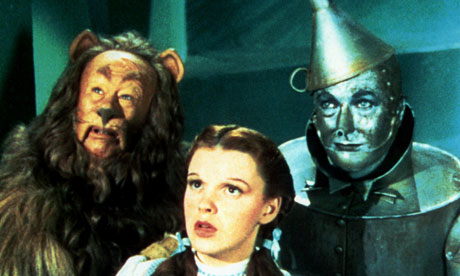Secret Teacher: leadership is like the Wizard of Oz - a facade that lacks magic
Senior leaders are drowning in paperwork rather than inspiring others, says Secret Teacher

School leaders: like the Wizard of Oz the higher echelons of school management are not what our blogger thought they would be.
In the Wizard of Oz, as Dorothy and the others seek an answer to their problems, there is an eventual realisation that there is no great cure or no great solution to any of the ailments they face. When they finally see the Wizard, they realise he is nothing more than a small, ordinary man who can no more grant courage than he can give hearts. By seeing behind the curtain, the magic disappears and they are presented with the harsh reality.
As a young teacher I aspired to greater things as I felt that those in positions of responsibility had a driving passion, excelled at their job and were able to make a difference. As I've climbed the rungs of the ladder though, I'm afraid to report that having seen behind the curtain, the world of SLT doesn't do the things it should. As I rose higher this soon became apparent. As head of department, I realised that the higher I got, the more paper was pushed and the less conversations about learning took place. Unperturbed I've continued the climb, only to find that the higher echelons of school management are not the places I expected them to be. I expected a table full of people striving to make a difference, outstanding teachers in their own field, each with strengths to develop this in others. And it isn't. Behind the curtain can actually be a depressing place.
It's a place, ironically, most teachers are looking to avoid - an office. A world of policies, guidelines, unions and grants. Of bizarre abbreviations, self evaluation forms (SEFs) and school development plans (SDPs) and a crescendo of paper shuffling. Most teachers go into the profession believing they can make a difference and those who look to progress do so in order to have more chance of doing this, but actually it's a place where capable staff are wading through bureaucracy.
So where's the blame? The academy status doesn't help. Schools were not designed to be businesses, they were designed to be places of learning and consequently the people at the top of them have an expertise in teaching, not in business. In the past week, my headteacher has suffered a three-hour finance meeting about the accounts of our new limited company, countless discussions about a proposed rebuild over part of our school that may/may not happen, and other uses of her day that don't relate to teaching and learning, all at a crucial time when we need to be doing something about our core subject results and raising standards in the classroom. We spend hours of SLT meetings discussing things that aren't related to students and their learning and something has to give.
As school leaders, we need to refocus on what's vitally important and find a way to leave the rest to other people. All school leaders started off as teachers and this needs to be what the focus returns to. Hiding away in offices studying policies and rewriting SEFs doesn't make a day-to-day impact on students. Senior staff need to be brave enough not to be distracted from the focus; that of creating a culture of good learning. We need to keep in mind what's important and shift the focus back to enabling students to do the very best they can and getting teachers to feel as empowered and motivated as possible. If schools are to become cathedrals of learning, we need to ensure that the focus is on what we're good at, and not on other things that sidetrack our time. Teaching has become a profession we're over-complicating.
In order to refocus US president Bill Clinton during his election campaign, concerned that the agenda was shifting daily away from what voters valued, his chief strategist James Carville hung a sign in the campaign office saying: "The economy, stupid." At the height of Disney's fame, as theme parks were being talked of and movies going global, founder Walt made the statement: "I only hope that we never lose sight of one thing – that it was all started by a mouse." Apparently this still hangs on the wall at Disney HQ as a reminder to all of where the focus is. Senior leaders need to look at what occupies their time and ask the question: "Is it going to directly improve the learning in my school?" And if it doesn't address that priority it needs to be done at another time by someone else. If we can do this, staff will feel more motivated, students more valued and standards will rise. It will also mean that the next generation of school leaders will be those who aspire to get behind the curtain and can join me in this good fight to do what we're good at, and leave the rest to the others.
Today's Secret Teacher is an assistant headteacher in the east of England.
As a young teacher I aspired to greater things as I felt that those in positions of responsibility had a driving passion, excelled at their job and were able to make a difference. As I've climbed the rungs of the ladder though, I'm afraid to report that having seen behind the curtain, the world of SLT doesn't do the things it should. As I rose higher this soon became apparent. As head of department, I realised that the higher I got, the more paper was pushed and the less conversations about learning took place. Unperturbed I've continued the climb, only to find that the higher echelons of school management are not the places I expected them to be. I expected a table full of people striving to make a difference, outstanding teachers in their own field, each with strengths to develop this in others. And it isn't. Behind the curtain can actually be a depressing place.
It's a place, ironically, most teachers are looking to avoid - an office. A world of policies, guidelines, unions and grants. Of bizarre abbreviations, self evaluation forms (SEFs) and school development plans (SDPs) and a crescendo of paper shuffling. Most teachers go into the profession believing they can make a difference and those who look to progress do so in order to have more chance of doing this, but actually it's a place where capable staff are wading through bureaucracy.
So where's the blame? The academy status doesn't help. Schools were not designed to be businesses, they were designed to be places of learning and consequently the people at the top of them have an expertise in teaching, not in business. In the past week, my headteacher has suffered a three-hour finance meeting about the accounts of our new limited company, countless discussions about a proposed rebuild over part of our school that may/may not happen, and other uses of her day that don't relate to teaching and learning, all at a crucial time when we need to be doing something about our core subject results and raising standards in the classroom. We spend hours of SLT meetings discussing things that aren't related to students and their learning and something has to give.
As school leaders, we need to refocus on what's vitally important and find a way to leave the rest to other people. All school leaders started off as teachers and this needs to be what the focus returns to. Hiding away in offices studying policies and rewriting SEFs doesn't make a day-to-day impact on students. Senior staff need to be brave enough not to be distracted from the focus; that of creating a culture of good learning. We need to keep in mind what's important and shift the focus back to enabling students to do the very best they can and getting teachers to feel as empowered and motivated as possible. If schools are to become cathedrals of learning, we need to ensure that the focus is on what we're good at, and not on other things that sidetrack our time. Teaching has become a profession we're over-complicating.
In order to refocus US president Bill Clinton during his election campaign, concerned that the agenda was shifting daily away from what voters valued, his chief strategist James Carville hung a sign in the campaign office saying: "The economy, stupid." At the height of Disney's fame, as theme parks were being talked of and movies going global, founder Walt made the statement: "I only hope that we never lose sight of one thing – that it was all started by a mouse." Apparently this still hangs on the wall at Disney HQ as a reminder to all of where the focus is. Senior leaders need to look at what occupies their time and ask the question: "Is it going to directly improve the learning in my school?" And if it doesn't address that priority it needs to be done at another time by someone else. If we can do this, staff will feel more motivated, students more valued and standards will rise. It will also mean that the next generation of school leaders will be those who aspire to get behind the curtain and can join me in this good fight to do what we're good at, and leave the rest to the others.
Today's Secret Teacher is an assistant headteacher in the east of England.

























-thumb-225x224-32143.jpeg)











